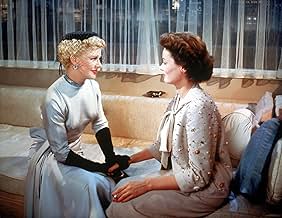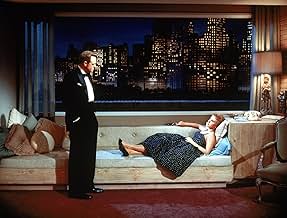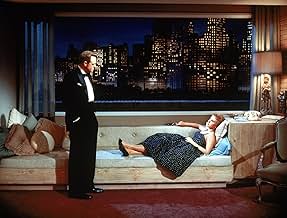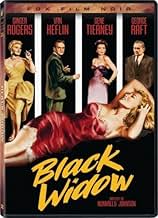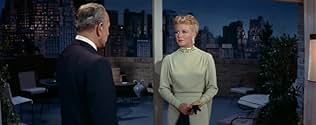NOTE IMDb
6,7/10
3,5 k
MA NOTE
Ajouter une intrigue dans votre langueAn aspiring young writer insinuates herself into the life of a Broadway producer only to meet an unexpected fate.An aspiring young writer insinuates herself into the life of a Broadway producer only to meet an unexpected fate.An aspiring young writer insinuates herself into the life of a Broadway producer only to meet an unexpected fate.
- Réalisation
- Scénario
- Casting principal
Mabel Albertson
- Sylvia
- (non crédité)
Edward Astran
- Party Guest
- (non crédité)
Bea Benaderet
- Mrs. Franklin Walsh
- (non crédité)
Mary Benoit
- Party Guest
- (non crédité)
Nesdon Booth
- Police A.P.B. Man
- (non crédité)
Paul Bradley
- Party Guest
- (non crédité)
Steve Carruthers
- Party Guest
- (non crédité)
Avis à la une
When I watched this movie on DVD, the plot and characters seemed familiar. I realized that the story was based on an episode in the "Peter Duluth" series by Patrick Quentin. For some reason, they changed the character's name to Peter Denver - maybe they thought it was easier to pronounce.
"Patrick Quentin" was a pen name used by four different writers in various combinations from around 1930 into the 1960s. They also used the names Q. Patrick and Jonathan Stagge. See the Wikipedia article on Patrick Quentin for more details.
The best known Patrick Quentin novels are those featuring Peter Duluth, a Broadway producer, and his wife Iris, a famous actress. They solve mysteries in the glamorous New York theatre world - a bit like Nick and Nora Charles. Most of these novels have the word "puzzle" in the title - "Puzzle for Fools", "Puzzle for Players", etc. "Black Widow", published in 1952, was an exception to the title pattern. All of the Duluth novels I have read have been very entertaining "Golden Age" mysteries, and I highly recommend them to mystery fans. In fact, all of the books by Patrick Quentin or any of his pseudonyms that I have read have been very good mysteries.
I was surprised that this script was given such high-end treatment - Cinemascope Technicolor and stereo sound. The script is a bit old fashioned, with its narration and flashbacks, and the cast is so-so. I think Peter Duluth was intended to be a more dashing character than the rather frumpy Van Heflin could convey. Cary Grant would have been perfect in the role. I still found it an entertaining 90 minutes. But check out the Peter Duluth books for a truly good read.
"Patrick Quentin" was a pen name used by four different writers in various combinations from around 1930 into the 1960s. They also used the names Q. Patrick and Jonathan Stagge. See the Wikipedia article on Patrick Quentin for more details.
The best known Patrick Quentin novels are those featuring Peter Duluth, a Broadway producer, and his wife Iris, a famous actress. They solve mysteries in the glamorous New York theatre world - a bit like Nick and Nora Charles. Most of these novels have the word "puzzle" in the title - "Puzzle for Fools", "Puzzle for Players", etc. "Black Widow", published in 1952, was an exception to the title pattern. All of the Duluth novels I have read have been very entertaining "Golden Age" mysteries, and I highly recommend them to mystery fans. In fact, all of the books by Patrick Quentin or any of his pseudonyms that I have read have been very good mysteries.
I was surprised that this script was given such high-end treatment - Cinemascope Technicolor and stereo sound. The script is a bit old fashioned, with its narration and flashbacks, and the cast is so-so. I think Peter Duluth was intended to be a more dashing character than the rather frumpy Van Heflin could convey. Cary Grant would have been perfect in the role. I still found it an entertaining 90 minutes. But check out the Peter Duluth books for a truly good read.
Five years earlier, this drawingroom drama would have been filmed in small screen b&w. But the year is 1954 and film audiences are staying home with their new-fangled little black boxes. So a big budget studio like TCF takes what amounts to an "Ellery Queen in Manhattan" plot, gussies it up in lavish color, stretches the screen to Cinemascope length, loads up the marquee with big names, and sends the result out to compete with Lucille Ball and Milton Berle. I don't know how well the strategy succeeded commercially, but I enjoyed the movie then and still do.
As a whodunit, the mystery's only partially successful—not enough suspects and too convoluted to follow. At the same time, the pacing sometimes sags in ways that undercut the suspense. Still, the 95 minutes does add up to a gorgeous tapestry, thanks to expert art direction, set decoration, and a well-upholstered cast. And who could hold together a sometimes-confusing storyline better than the always-reliable Van Heflin. Also, I expect urbane writer-director Nunnally Johnson fit comfortably with the sophisticated Manhattan setting and show-biz personalities. So, it's not surprising that he gets off some insider innuendo. Catch the cocktail party shot at gossip columnist Hedda Hopper, known for her bizarre headgear; I expect Johnson was settling an old score there. Then too, having the ingénue (Garner) turn up mysteriously pregnant is rather daring for the straitjacketed Production Code period. Also, watch for the skinny young actor (Oliver) interviewed by Heflin near film's end. That's future TV mogul Aaron Spelling getting a proverbial foot in the door.
Anyway, the film provides an entertaining glimpse of drawingroom drama getting a face-lift during the early years of the television challenge.
As a whodunit, the mystery's only partially successful—not enough suspects and too convoluted to follow. At the same time, the pacing sometimes sags in ways that undercut the suspense. Still, the 95 minutes does add up to a gorgeous tapestry, thanks to expert art direction, set decoration, and a well-upholstered cast. And who could hold together a sometimes-confusing storyline better than the always-reliable Van Heflin. Also, I expect urbane writer-director Nunnally Johnson fit comfortably with the sophisticated Manhattan setting and show-biz personalities. So, it's not surprising that he gets off some insider innuendo. Catch the cocktail party shot at gossip columnist Hedda Hopper, known for her bizarre headgear; I expect Johnson was settling an old score there. Then too, having the ingénue (Garner) turn up mysteriously pregnant is rather daring for the straitjacketed Production Code period. Also, watch for the skinny young actor (Oliver) interviewed by Heflin near film's end. That's future TV mogul Aaron Spelling getting a proverbial foot in the door.
Anyway, the film provides an entertaining glimpse of drawingroom drama getting a face-lift during the early years of the television challenge.
This is a colourful mystery yarn, nothing to deep or steep, with a limited pallet of suspects. In the right hands this could of been a decent "Film Noir" but the colour all rather lush and plush on top of highly unsuitable widescreen which mostly ruins the framing of the actors while giving this studio shot film an artificial look that undermines the suspense. Nonetheless, this is enjoyable froth nicely dated and a good movie for a wet and lazy afternoon.
I greatly enjoyed this Cinemascope, Stereo-Sound romp, but mainly as a Guilty Pleasure, as it's a film very much of it's time, with mismatched acting styles, lush, unbelievable sets, a central premise that doesn't make much sense (lending your expensive apartment to a just-met down-and-out writer while your wife's away),and an early attempt to make visual sense of the then-new wide-screen process.
Why do I like it? Ginger Rogers is way over the top, popping on and off screen with snappy diva one-liners, like Margo Channing on pep pills; Peggy Ann Garner plays a subversive Lolita, crazy-seductive and irresistible, and you can even spot Aaron Spelling towards the end in a bit part as a theatre employee.
The palette is loaded with pastel colors so popular in the 1950's, and the whole thing is sort of a mild domestic whodunit whipped up into an anemic Douglas Sirk confection. Great it ain't, but because of Rogers, Van Heflin, Gene Tierney (who has very little to do but does it beautifully) and Reginald Gardner, I found it greatly entertaining.
Why do I like it? Ginger Rogers is way over the top, popping on and off screen with snappy diva one-liners, like Margo Channing on pep pills; Peggy Ann Garner plays a subversive Lolita, crazy-seductive and irresistible, and you can even spot Aaron Spelling towards the end in a bit part as a theatre employee.
The palette is loaded with pastel colors so popular in the 1950's, and the whole thing is sort of a mild domestic whodunit whipped up into an anemic Douglas Sirk confection. Great it ain't, but because of Rogers, Van Heflin, Gene Tierney (who has very little to do but does it beautifully) and Reginald Gardner, I found it greatly entertaining.
Very impressive cast in a better than OK murder mystery. With touches of All About Eve and Sunset Boulevard, this film moves along at a good clip with only a few draggy scenes.
Ginger Rogers plays a bitchy stage diva who is married to a mousy man (Reginald Gardiner) and lives in the same apartment building as her producer (Van Heflin) who is also married to an actress (Gene Tierney). While Tierney is away, Heflin attends one of Rogers' big parties and meets a quiet young woman (Peggy Ann Garner) who actually has no real interest in acting or theatre. She is a writer. He invites her out for a real meal and she insinuates herself into his life.
The party scene is pretty funny with Ginger ripping off several "Margo Channing" ripostes at the expense of Bea Benaderet. Heflin is infatuated with the serious young Garner whose only link to the stage is her uncle (Otto Kruger) who is an actor. She also befriends a young brother and sister from Boston (Virginia Leith & Skip Homeier) who are doing the Greenwicj Village beatnik thing.
Well there is an apparent suicide and that brings in a detective (George Raft) who hounds everyone. When the suicide is discovered to be a murder, things get really dicey for all involved.
For the most part the acting is solid. I never liked Heflin but he's OK in this film. Rogers plays the diva well and looks great. Tierney gets a few good scenes. Raft is solid as the detective. Gardiner is especially good, but Peggy Ann Garner, a top child star of the 40s is quite excellent as the moody and strange young writer. Oddly, she didn't make a film after this one for another 12 years. She reminds me here of Barbara Bel Geddes. Bea Benaderet as the party guest, Otto Kruger as the uncle, and Leith and Homeier as the beatniks are all good.
Also in this film are Cathleen Nesbitt oddly cast as a cleaning lady, Mabel Albertson is the bar owner, Hilda Simms plays the sympathetic waitress, and believe it or not, the gangly witness from the movie theater is Aaron Spelling, who would have a major career as a TV producer.
Worth a watch.
Ginger Rogers plays a bitchy stage diva who is married to a mousy man (Reginald Gardiner) and lives in the same apartment building as her producer (Van Heflin) who is also married to an actress (Gene Tierney). While Tierney is away, Heflin attends one of Rogers' big parties and meets a quiet young woman (Peggy Ann Garner) who actually has no real interest in acting or theatre. She is a writer. He invites her out for a real meal and she insinuates herself into his life.
The party scene is pretty funny with Ginger ripping off several "Margo Channing" ripostes at the expense of Bea Benaderet. Heflin is infatuated with the serious young Garner whose only link to the stage is her uncle (Otto Kruger) who is an actor. She also befriends a young brother and sister from Boston (Virginia Leith & Skip Homeier) who are doing the Greenwicj Village beatnik thing.
Well there is an apparent suicide and that brings in a detective (George Raft) who hounds everyone. When the suicide is discovered to be a murder, things get really dicey for all involved.
For the most part the acting is solid. I never liked Heflin but he's OK in this film. Rogers plays the diva well and looks great. Tierney gets a few good scenes. Raft is solid as the detective. Gardiner is especially good, but Peggy Ann Garner, a top child star of the 40s is quite excellent as the moody and strange young writer. Oddly, she didn't make a film after this one for another 12 years. She reminds me here of Barbara Bel Geddes. Bea Benaderet as the party guest, Otto Kruger as the uncle, and Leith and Homeier as the beatniks are all good.
Also in this film are Cathleen Nesbitt oddly cast as a cleaning lady, Mabel Albertson is the bar owner, Hilda Simms plays the sympathetic waitress, and believe it or not, the gangly witness from the movie theater is Aaron Spelling, who would have a major career as a TV producer.
Worth a watch.
Le saviez-vous
- AnecdotesNunnally Johnson originally offered the role played by Ginger Rogers to Tallulah Bankhead, who called the writer-producer and, in a 25-minute phone conversation, gave him her reasons for rejecting the role. Rogers turned the part down as well, but had a change of heart after Johnson sent her a letter asking her to reconsider, on the proviso that she could take the relatively minor role and make it into a star-turn.
- GaffesWhen the suicide note is discovered by the Denvers, it is lying, uncreased, on the table. Later, during questioning, the detective produces it, folded up, from his pocket. A cop would never mishandle and mutilate evidence that way.
- Citations
[opening narration]
Peter Denver: The Black Widow, deadliest of all spiders, earned its dark title through its deplorable practice of devouring its mate.
- Crédits fousOpening credits are shown over the background of a spider web made by a black widow.
- ConnexionsFeatured in Ginger Rogers at Twentieth Century Fox (2007)
- Bandes originalesTheme from 'Dance of the Seven Veils'
from "Salome"
by Richard Strauss
[Played occasionally throughout the picture]
Meilleurs choix
Connectez-vous pour évaluer et suivre la liste de favoris afin de recevoir des recommandations personnalisées
- How long is Black Widow?Alimenté par Alexa
Détails
- Date de sortie
- Pays d’origine
- Langue
- Aussi connu sous le nom de
- La viuda negra
- Lieux de tournage
- 1515 Broadway, Manhattan, Ville de New York, New York, États-Unis(Hotel Astor exterior near Times Square)
- Société de production
- Voir plus de crédits d'entreprise sur IMDbPro
Box-office
- Budget
- 1 095 000 $US (estimé)
- Durée
- 1h 35min(95 min)
- Couleur
- Rapport de forme
- 2.55 : 1
Contribuer à cette page
Suggérer une modification ou ajouter du contenu manquant


